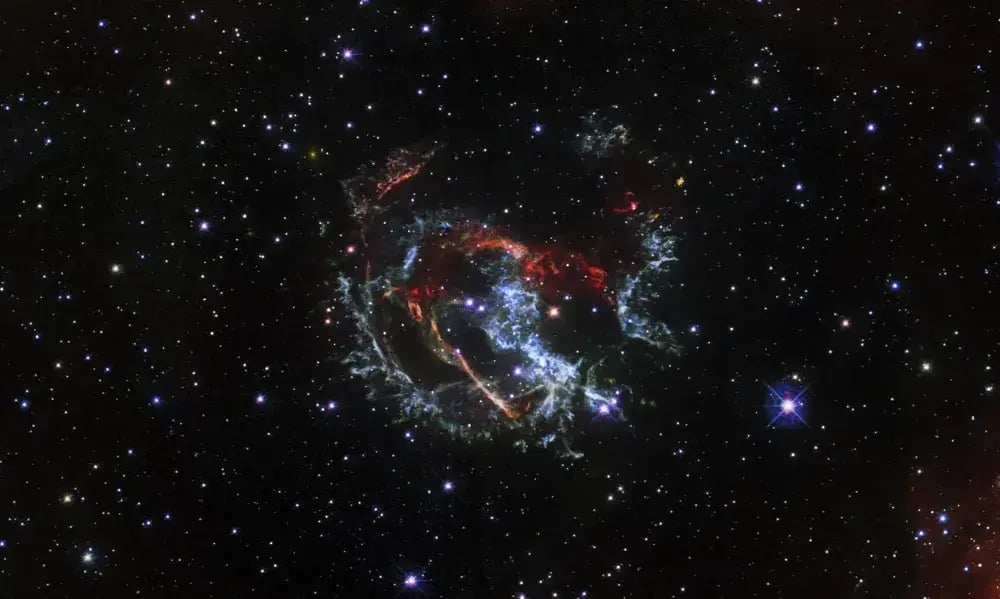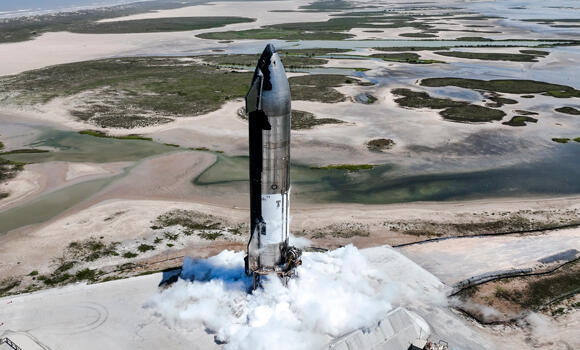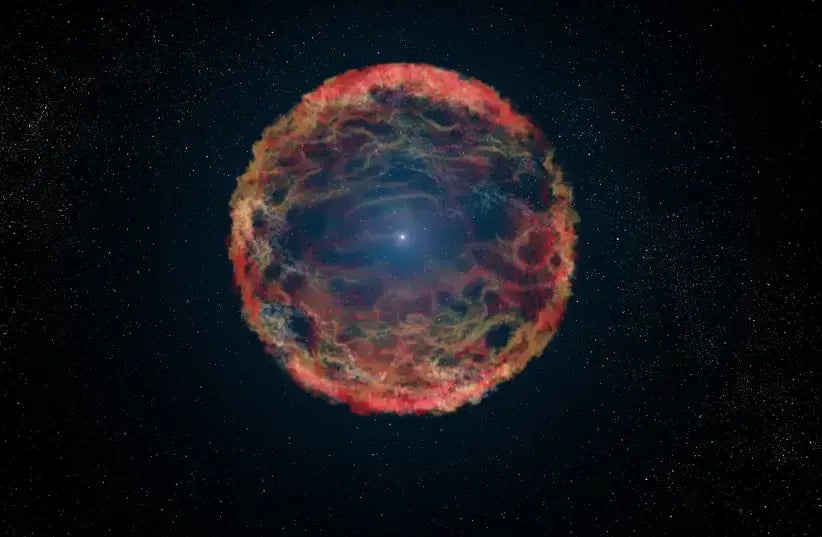Was a neutron star born?
In astrophysics, a widely accepted view is that extremely dense bodies with intense gravitational forces, such as neutron stars or black holes, collectively referred to as "compact objects," originate from the remnants of a massive star that has undergone a supernova explosion.
Read more:
Although substantial evidence supports this idea, much of it remains largely circumstantial. Recent research, led by scientists from the Weizmann Institute of Science, provides significant reinforcement for this theory through the observation of a compact object immediately following a supernova.
"We know that most stars with a mass 8-10 times greater than our Sun are expected to end their life cycle in such a cataclysmic explosion, and we know that the majority of these stars are found within binary systems, in which two stars orbit each other. We also know that compact objects are often found in binary systems and eventually collide and merge, as shown by gravitational wave detectors, LIGO," explained the head of the research team, Professor Avishay Gal-Yam from the Weizmann Institute of Science.
"So we know what the system looks like at the beginning, middle, and end of the process, but we don't understand how the process occurs and what happens in the system. For example: How does the explosion of one star in a binary system not significantly alter its partner's orbit? Some researchers believe that a supernova of one of the stars causes the system to disintegrate, and the remaining compact object drifts through space until it encounters another compact partner."
The turning point in the research occurred in May 2022, when an amateur astronomer spotted a new supernova from our perspective, in galaxy NGC157, situated 75 million light-years away from us. In typical supernovas, a sharp increase in light intensity is observed, followed by gradual fading. Dr. Ping Chen, a postdoctoral researcher at the Weizmann Institute of Science who followed the supernova's fading through the telescope of the European Southern Observatory (ESO) in Chile, noticed an unexpected fading pattern, which was not continuous.
"Instead of continuous fading, we observed periodic changes in light intensity, repeating hundreds of times with a consistent periodicity of 12.4 days. This pattern is characteristic of a binary system, where one object eclipses the other object or distorts its shape," Gal-Yam explained in a conversation with the Davidson Institute website.
The researchers did not stop at this observation, but also used a spectrometer to analyze the light composition of the supernova remnants. They discovered the presence of a hydrogen-containing object, which was not found in the initial observations, and noticed that it was approaching and receding from us with the same 12.4-day periodicity.
Another confirmation was received from gamma-ray measurements using NASA's Fermi space telescope, which also detected emissions at the same periodicity. "The conclusion is that after the explosion we are left with a system consisting of two bodies. One is compact, emitting gamma radiation, while the other, which did not explode, is a hydrogen-containing star, and they continue to orbit each other," explained Gal-Yam.
The study published in Nature journal also involved researchers from the Weizmann Institute of Science, including Eran Ofek, Boaz Katz, Doron Kushnir, Eli Waxman, Barak Zackay, Ido Irani, Amir Sharon, and Nora Lin Strotjohann, Assaf Horesh from the Hebrew University, and researchers from the United States, China, Australia, Sweden, Germany, and Denmark.
"This is the first time we see the transition from a massive star to a compact object within the same system, and in my opinion, it represents a significant breakthrough in this field," summarized Gal-Yam.
"As a research student, I was surprised to learn that the theory of supernovas forming black holes was not yet proven, and I decided that I want to show it. Since then, there hasn't been much observational progress, but the new technologies, and the access to prolonged monitoring of this supernova with ESO's giant telescopes, allowed us to reach this discovery.
"Together with the previous research led by Chen, this work paves the way to understanding what happens after a supernova. I am optimistic that these capabilities will facilitate the development of methods for classifying these explosions, shedding light on the types of compact objects that emerge from each explosion and enhancing our understanding of their underlying mechanisms."
Gal-Yam further emphasized that this success highlights the need for Israel to join as a partner in international scientific organizations such as the ESO (European Southern Observatory). "Having access to cutting-edge telescopes is vital. We have excellent researchers and innovative science. However, we find ourselves at a disadvantage compared to scientists in less scientifically advanced nations who are affiliated with such international organizations." he pointed out.
The Israeli space telescope, ULTRASAT, currently under development at the Weizmann Institute of Science, slated for launch in 2026, aims to play a pivotal role in similar research efforts. It is designed not only for detecting supernovas but also for their ongoing surveillance, providing valuable data over extended periods.
Bitter disappointment on the way to the Moon
The Peregrine spacecraft, developed by Astrobotic, a United States-based company, was launched on its mission this week with the ambitious goal of becoming the first private spacecraft to land on the Moon, and the first American spacecraft to do so since Apollo 17 in 1972. This launch also marked the maiden flight of ULA's "Vulcan Centaur" rocket, a collaborative effort between Boeing and Lockheed Martin. The Vulcan Centaur aims to replace its heavy predecessors, the Atlas 5 and Delta 4 heavy rockets, and is equipped with state-of-the-art engines from Blue Origin.
3 View gallery


A Hubble image of an expanding, gaseous corpse — a supernova remnant — known as 1E 0102.2-7219
(Photo: AFP)
The new rocket successfully passed its initial test, placing the spacecraft in an elliptical orbit around Earth. The spacecraft was scheduled to adjust its orbit through engine maneuvers, with the aim to attempt landing on the Moon on February 23.
However, shortly after the spacecraft's separation from the rocket's second stage, a malfunction was detected. It prevented the spacecraft from orienting itself toward the Sun to recharge its batteries. Astrobotic later reported that their engineers managed to rotate the spacecraft, but it appears that a fuel leak from the spacecraft hindered its ability to orient itself for charging during the mission or perform the necessary maneuvers required to reach the Moon. “Given the situation, we have prioritized maximizing the science and data we can capture,” the company tweeted.
The company subsequently confirmed the presence of a fuel leak, attributing the malfunction to a defective valve in the helium tank, which is responsible for pressurizing the fuel and the oxidizing agent needed for combustion. As elaborated in a follow-up tweet by Astrobotic, the valve did not close, resulting in excessive helium pressure in the oxidizer tank and leading to a hole in the tank and the fuel leak. The landing attempt had to be abandoned, and it remains uncertain whether the spacecraft will even be able to approach the Moon before losing its maneuvering capabilities and, consequently, its power supply.
The spacecraft carries about 90 kilograms of experiments and scientific instruments, primarily for NASA, which also provided significant funding for the mission, as part of the CLPS program, aimed at launching agency payloads and experiments to the Moon aboard commercial spacecraft.
Additionally, the spacecraft carries a tiny rover constructed by students, and five ground robots of the Mexican space agency. The spacecraft was supposed to deliver to the Moon the remains of dozens of individuals who wished to be interred on the Moon, including science fiction writer Arthur C. Clarke and "Star Trek" creator Gene Roddenberry, as well as one dog.
This marked the third attempt to land a private spacecraft on the Moon, after the failures of the Israeli SpaceIL and the Japanese ispace, which at least reached the Moon, and crashed during the landing maneuver. Another attempt is expected next month, with the landing of Nova-C by Intuitive Machines, intended for launch on a SpaceX Falcon 9 rocket. Firefly, drawing inspiration from the Israeli 'Beresheet' mission, may also undertake a private lunar mission later this year.
One small step forward, two steps back
The challenge of landing on the Moon is not exclusive to private companies. NASA itself is grappling with its own set of challenges in its ambitious endeavor to land humans again on our natural satellite. The challenge of landing on the Moon is not exclusive to private companies; NASA, the United States' premier space agency, is grappling with its own set of challenges in its ambitious endeavor to return humans to our natural satellite.
3 View gallery


Starship 25 during the engine test at SpaceX's space base in Texas, June 26, 2023
(Photo: SpaceX)
During a press conference this week, senior officials from the space agency confirmed what had been anticipated – significant delays in the Artemis program missions. Artemis 2 mission, which involves a crew of four astronauts orbiting the Moon in the Orion spacecraft without landing, has been postponed from November of this year to September 2025. The Artemis 3 mission, slated to mark the first human landing on the Moon since 1972, was originally targeted for late 2025 but has now been rescheduled to September 2026.
The primary cause of these delays can be attributed to safety considerations, due to several failures discovered in the spacecraft. A major point of concern is the Orion spacecraft's heat shield. Despite its successful performance during the uncrewed Artemis 1 mission's re-entry, subsequent tests revealed that the shield lost more material than anticipated. The shield's ablative layer, designed to burn off and dissipate heat through atmospheric friction, has not met durability expectations.
Additionally, the spacecraft's escape system, intended to activate in case of launch rocket failures and safely evacuate the astronauts, still has not met the expected performance levels in tests. NASA is also exploring the development of a new rapid crew egress system for situations requiring swift exit from the spacecraft, as well as enhancements to Orion's life support systems. Additional delays are arising from the installation of new systems at the Kennedy Space Center launch facilities in Florida, including a high-speed fueling system.
And we cannot fail to mention the elephant in the room, which was not mentioned in the press conference – SpaceX's Starship. The giant spacecraft was selected to transport astronauts on the Moon in the initial missions and also serve as a refueling vessel for those missions. The first test of the Starship in April 2023 ended in an explosion after the spacecraft failed to separate from the launch rocket.
In a subsequent test in November, it managed to reach space but exploded there without completing the intended mission. SpaceX is currently planning a third test of the new spacecraft in February. Another delay in its development could lead to further postponements in the scheduled manned missions to the Moon.
The U.S. Government Accountability Office (GAO), often referred to as the U.S. equivalent of the State Comptroller, has recently cautioned that delays in both the landing vehicle's development and in the production of new space suits by Axiom could postpone the manned lunar landings until at least 2027.
X-ray imaging of supernova remnants
The Japanese X-ray telescope XRISM, launched in September 2023 and operated in collaboration with NASA and other organizations, has produced initial test images of two cosmic objects: supernova remnants and a distant galaxy cluster.
The primary mission of this telescope is to investigate violent cosmic events that emit intense radiation and provide insights into fundamental questions about the composition of matter in the universe. Key questions it aims to answer involve the development of galaxy clusters, the dispersion of matter in the cosmos (addressing the 'missing baryon' issue), and elucidating the processes that lead to the formation of new elements as part of stellar explosions or supernovas.
The supernova remnants captured by XRISM, known as N123D, represent prominent X-ray sources located in the Small Magellanic Cloud, a galaxy situated in close proximity to our Milky Way. These remnants are believed to be the aftermath of a star that exploded approximately 3,000 years ago as observed from our vantage point.
The telescope also conducted spectroscopic measurements to analyze the composition of the remnants' material, revealing the presence of elements such as silicon, sulfur, calcium, argon, and iron. Researchers anticipate that these measurements will contribute to our understanding of the composition of matter persisting in space following such stellar explosions, shedding light on the formation of heavy elements within supernovas.
- Content distributed by Davidson Institute of Science



